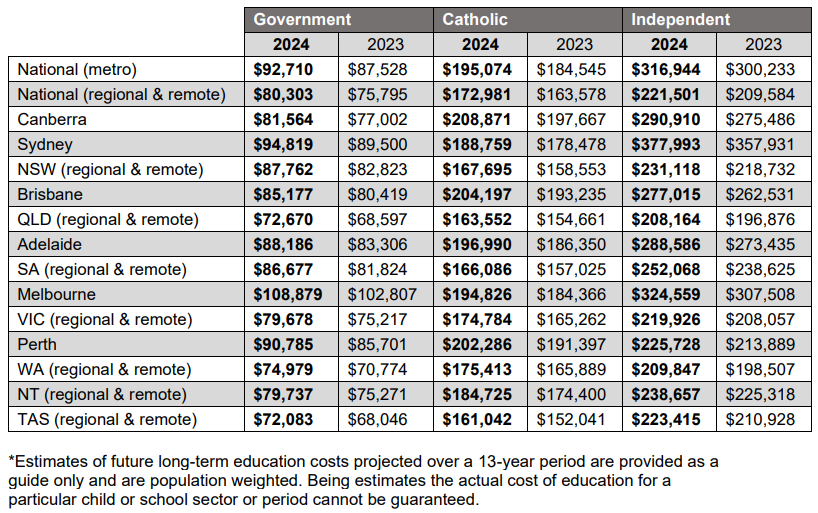
A new report has revealed the most, and least, affordable cities in Australia when it comes to sending a child to school.
The Futurity Investment Group’s Investment in Education Index (2024), released today, follows a nationwide survey of Australian parents with children enrolled in Government, Catholic and Independent schools.
Melbourne was found to be Australia’s most expensive city for a Government education at $108,879 (an increase of $6,072 compared to last year), while Canberra ranked as Australia’s most affordable city for that sector.
For a Catholic education, Canberra was Australia’s most expensive city at $208,871 (an increase of $11,204 compared to 2023), while Sydney was the nation’s most affordable at $188,759 over 13 years for a child starting school in 2024 – an increase of $10,281 compared to last year.
However, Sydney remains Australia’s most expensive city for an Independent education at $377,993 – an increase of $20,062 compared to last year. Perth was Australia’s most affordable city for an Independent education, with the total cost of sending a child to school in that sector estimated at $225,728 over 13 years for a child starting school in 2024 – an increase of $11,839 compared 2022.
A new report has revealed the most, and least, affordable cities in Australia when it comes to sending a child to school.
The Futurity Investment Group’s Investment in Education Index (2024), released today, follows a nationwide survey of Australian parents with children enrolled in Government, Catholic and Independent schools.
Melbourne was found to be Australia’s most expensive city for a Government education at $108,879 (an increase of $6,072 compared to last year), while Canberra ranked as Australia’s most affordable city for that sector.
For a Catholic education, Canberra was Australia’s most expensive city at $208,871 (an increase of $11,204 compared to 2023), while Sydney was the nation’s most affordable at $188,759 over 13 years for a child starting school in 2024 – an increase of $10,281 compared to last year.
However, Sydney remains Australia’s most expensive city for an Independent education at $377,993 – an increase of $20,062 compared to last year. Perth was Australia’s most affordable city for an Independent education, with the total cost of sending a child to school in that sector estimated at $225,728 over 13 years for a child starting school in 2024 – an increase of $11,839 compared 2022.

Futurity Investment Group CEO, Sam Sondhi, said the costs associated with education are placing a substantial burden on many Australian families.
“Households are already stretched by spiralling cost of living and interest rate pressures,” Sondhi said.
“With less discretionary money to spend, it’s going to be a challenge for many families to pay for the total cost of education, which has jumped 6% in the past year.”
Sondhi said it is forecast that school fees and a host of major school expenses including outside tuition, school camps, transport, uniforms, electronic devices and sports equipment will increase upwards of 14% in the next five years, and by almost 30% in the next decade.
“Parents who have planned and saved for education will be in a better position in the long run and will be able to explore and afford choice when it comes to their children’s education.”
Futurity Investment Group CEO, Sam Sondhi, said the costs associated with education are placing a substantial burden on many Australian families.
“Households are already stretched by spiralling cost of living and interest rate pressures,” Sondhi said.
“With less discretionary money to spend, it’s going to be a challenge for many families to pay for the total cost of education, which has jumped 6% in the past year.”
Sondhi said it is forecast that school fees and a host of major school expenses including outside tuition, school camps, transport, uniforms, electronic devices and sports equipment will increase upwards of 14% in the next five years, and by almost 30% in the next decade.
“Parents who have planned and saved for education will be in a better position in the long run and will be able to explore and afford choice when it comes to their children’s education.”


